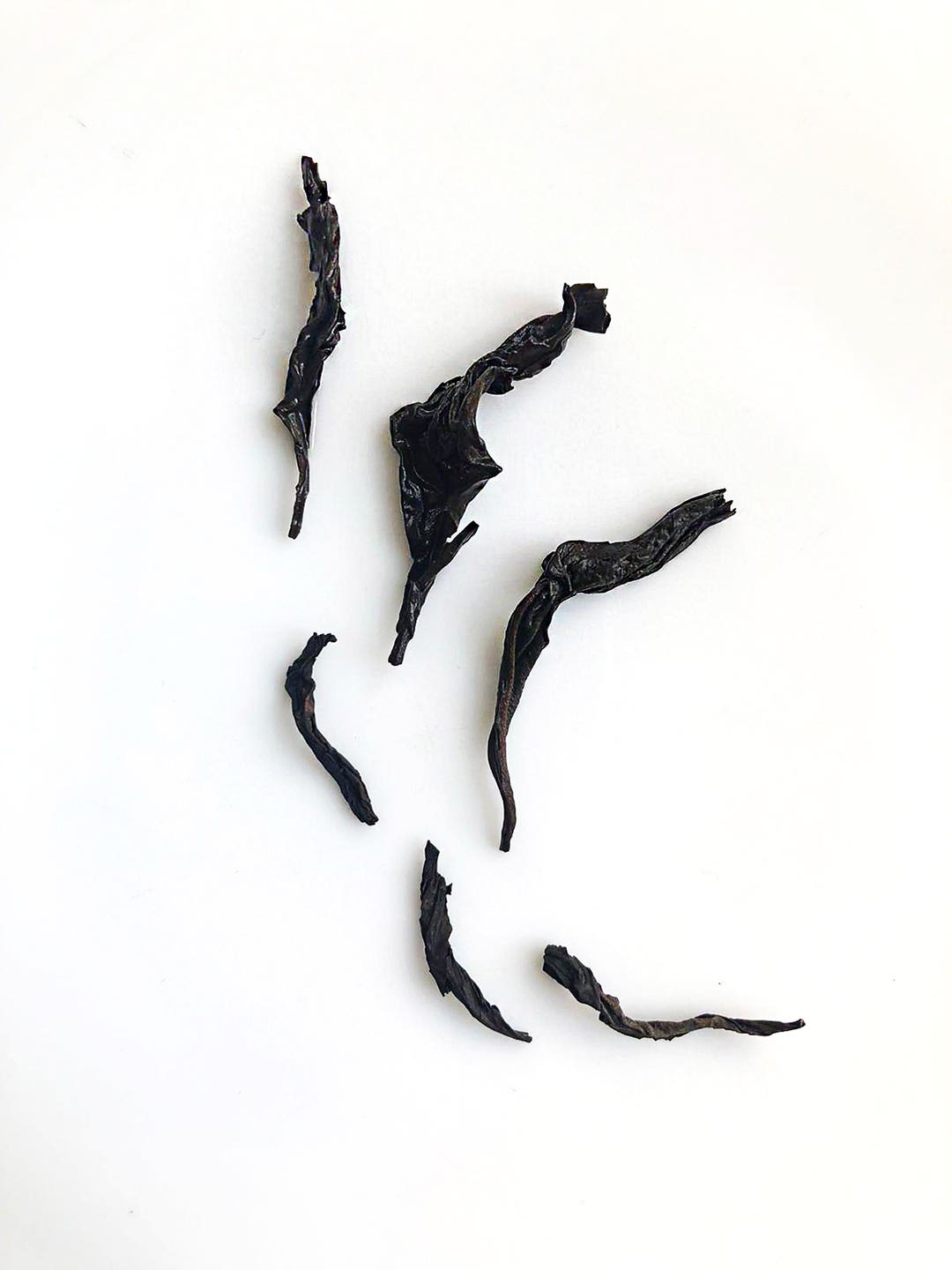A Deep Dive Into Our Wuyi Oolong Tea
Wuyi Oolong (Huang Meigui), Spring 2019, produced on May 3rd by Zhong Yuanlin in Huangcun Garden.
In this piece we dive into our latest batch of Wuyi Oolong, what makes it special, why we selected it, who we think will enjoy it and the best ways to find flavour, balance and enjoyment in this famous type of tea.
Wuyishan is famous for its production of textured, fruit, mineral and sweet tasting baked oolongs. We have chosen this batch from a relatively new cultivar and it is our first batch from Mr Zhong, who is farming in Huangcun, a village within the outer boundary of the Wuyi national park. It stood out to us because of its balance of florality with texture. It is sweet, prominent in mineral-earth flavours, and has a thick and satisfying mouthfeel.
The complexity of flavour makes this a very interesting tea – and one that is relatively difficult to describe! We love making this tea gong fu style and noticing the flavour changing with the infusions. We turn to it also in the afternoon, it satisfies on those busier days, providing interest but also the ease of sweetness as it cools in the mug.
Origin: Huangcun Garden, Wuyi, Fujian, China.
Cultivar: Camellia sinensis var. sinensis “Huang Meigui” (Yellow Rose).
Name: Named after the origin, Wuyishan.
Style: Roasted mid oxidised oolong.
Terroir: Wuyi Mountain, Northern Fujian. Teas from this area are known as Yan Cha or Rock Tea, so called because of rocky soil and craggy rock faces that the tea bushed grow.
Picking Season: Spring
Leaf: Twisted leaves
Oxidation: 30%
Production: Organic principles
Infusion: Deep russet-amber
What kind of teas are produced in the Wuyi Mountains?
The climate is subtropical, so it has high humidity and a lot of rain. The terrain is rugged, made up of volcanic rock, grey granite and red sandstone. The mountains are sometimes craggy with the tea bushes growing high and wherever they can among them. This rocky terrain/ growing condition is why the teas are sometimes known as Yancha or Rock Tea. From this, minerality in taste is expected and sought after. Mature/ older leaves from the bushes are usually used – a deep green, they are often rough looking, a world away from the tender young buds that are prized in many other tea origins.
Although oolongs from Wuyi can look very dark, this is not always because they are heavily oxidised (the oxidation is usually only around 30%), but from the baking which happens after the leaves have been processed and rested for a few weeks. This baking, usually in a basket over charcoal, mellows the green flavours, drawing out sweetness and the lightens the structure of the tea (the leaves being still 70% unoxidized, they are still quite green).
If you know oolongs from Wuyi, you will know the unique (and difficult to describe!) combination of minerality, fruitiness, chocolate, sweetness and structure – this batch has all of that character, and we’ve prioritised a relatively low level of baking, to retain the floral aromas and a fresh, lightness to it.

How did we find this batch of tea and who made it?
When we tried the tea from Mr Zhong, we really like the prominence of the floral notes balanced by the sweetness and the body. It was a new cultivar to us - Huang Meigui was developed only in 2002, specifically to be lighter in body than other local cultivars and to emphasise florality. Mr Zhong doesn’t work with pesticides which is typical for the region given the nature reserve status. The cultivar name translates as “yellow rose” the yellow referring to the colour of the leaves and the rose to the highly floral character.
We have two challenges in sourcing Wuyi oolong. The first is that because this area is considered the birthplace of oolong tea, teas from here have a very high cultural value, and so the domestic market dominates – this means preferences for style but also the domestic market does not look for pesticide free/ organic tea to the same extent that we do. The leaves are sometimes over baked to mask a lower quality base leaf. Over baking leaves the tea quite lifeless, but still drinkable (which is why producers continue to do this). It is hard therefore to get hold of the lighter baked, high quality teas.

What is this batch like to drink? Aroma, Taste and Texture
It is rich to drink, it is nutty with some cacao (ie, bitter chocolate) and a stone fruitiness, specifically peach. It has significant structure that comes from the minerality, the oxidation and the firing which means that for most people this tea will feel very different on the palate compared to lots of other teas - for example high mountain oolongs from Taiwan that will feel almost juicy or a Silver Needle which feels soft and super smooth.
The fruit is best described as ripe rather than dried, it is reminiscent of this being just a 30% oxidised tea and the leaves being somewhat green. The best way we think to describe this is to think of an unripe fruit that has been cooked and caramelised. The sweetness in the cup is like cooked sugar and comes from the baking. The aromas are highly floral and, as per the cultivar name, we can pick out rose.

Where and when is this tea for?
It is an energising drink and so it works well when you are tired in the morning and it is great instead of coffee. It goes really well with certain foods, especially spicy and rich flavours, and with its characteristic structure it will cut through oily/ fatty food. It is perfect with chocolate and is a great digestive.
Using just a simple tea pot like a tea-iere and infusing for three minutes, you will get a thick, interesting and rewarding drink. Many people will enjoy Wuyi in this way in the early afternoon, after lunch as a digestive, finding satisfaction from this thickness - a pick-me-up from its strength and interest in its complexity.
It is also for when you want to take time to savour the flavours over many infusions, perhaps preparing it ‘gong fu’ style.

What is it like to make and how easy is it to get a good taste?
In a single teapot and cup:
The simplest way to make this tea will reliably deliver thickness - through the sweet, autumn fruit flavours - and it will be clear that this is a complex drink. Infuse the leaves in a small teapot (the same size/ capacity as your cup) and pour the whole infusion into your cup. During a busy afternoon drinking this batch in this way, we noticed the sweetness becoming prominent as the infusion cooled. It can take up to fifteen minutes to drink, so plenty of time for the flavours to develop.
This works well: 4g/ 250ml; 100 degrees; 3 minutes per infusion (minimum 2 infusions)
Gong Fu:
Hailing from Wuyi’s province of Fujian, ‘gong fu’ preparation is a natural fit. Use a very small clay teapot or a Gaiwan. When we were experimenting with this Wuyi, we used our Tea Master and just 4g in 125ml of water. This works out at double the proportion than the full cup style above, but is low compared to the 6-12g that we use for some oolongs. We also like slightly cooler water when making the tea this way – both come together to give great definition in the infusions of the best characteristics of Wuyi. The bake comes off in the first infusion – it’s roasted and floral; the second infusion shows the sweetness, lots of caramel and lots of the cooked stone fruit. By the third infusion the structure is showing and sharing this idea of the mineral rock earthy flavours. There is so much to be found in Wuyi Oolong – it is great to explore in this way.
We like it with 4g/ 125ml; 90 degrees; 1 minute per infusion – experiment with even shorter for the first infusion (30-45 seconds) for lots of floral.
Who is this tea for?
This tea is sweet, moreish, with a little cacao. If you like tea that has complexity, minerality, structure, sweetness, fruit and still has some freshness to it, this is a tea for you. It is accessible but it has a lot of connoisseur value – it will appeal to black tea drinkers who want something slightly lighter and with freshness; and green oolong drinkers who want something warmer and more structured.
That said, if you are not interested in complexity of taste but just want something that is really moreish and satisfying, this could be an amazing tea for you.


